I wish to create a video game
Ben, wish granted in 2004
leukemia
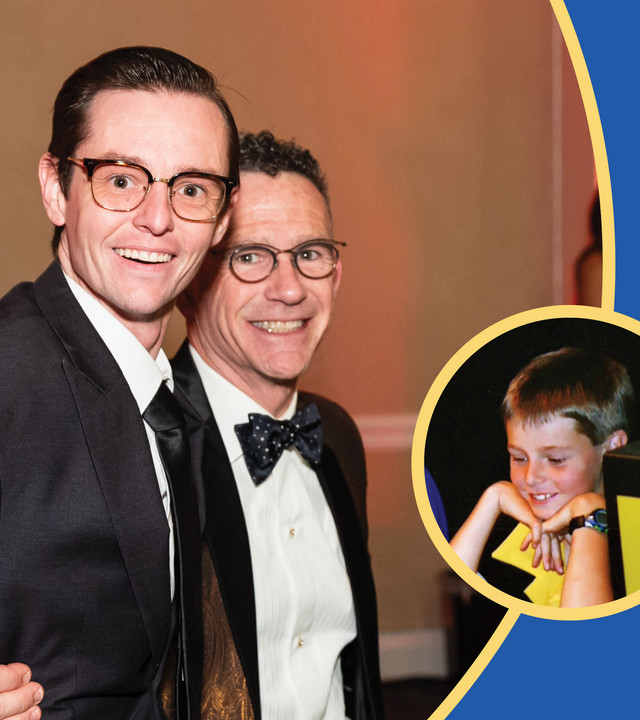
Changing the game
By Kali Sherman
In 2001, five-year-old Ben was leveling up in his favorite video games when life hit him with the toughest level yet—a real-life battle against leukemia.
“I didn’t know what was going on at all,” said Ben, recalling his hospital experience as a child. “All I remember was that my parents were under a lot of stress.”
Ben had to undergo chemotherapy treatment three times a week for the next three and a half years. Already a passionate gamer, he used video games as a coping mechanism and a way to escape from his illness and the side effects of his treatment.
When Ben’s doctor suggested he find ways to visualize his body healing, Ben imagined his medicine as Pac-Man, gobbling up the cancer cells. He started to think of his battle with the leukemia like levels in a game.
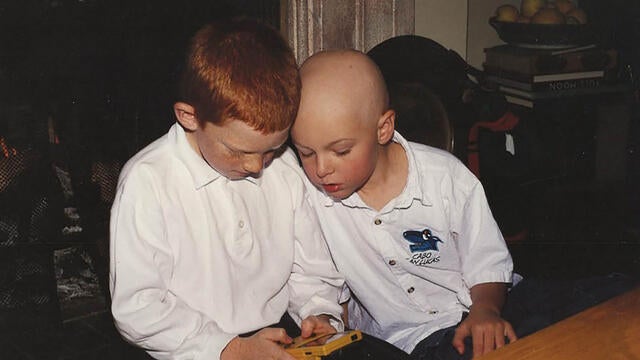
Ben and a friend play video games while Ben was undergoing treatment in 2001.
At 8 years old, Ben received a wish. He immediately thought about how he could use it to help others. “I remember seeing a lot of kids in my position,” said Ben. “I just wanted to figure out a way to help them. There weren’t many portable electronics to keep your mind busy while getting treatment during that time.”
Inspired by what helped him get through treatment, Ben wished to design a video game that could bring hope and strength to other kids battling cancer.
“I wanted to fight cancer the way I fought it in real life,” said Ben. “I wanted to give other kids an opportunity to understand the side effects they were going through.”
The chapter faced a daunting challenge in making Ben’s wish come true—in the early 2000s, developing video games was expensive and not that many people had the skillset to do it.
“The initial response was overwhelmingly pessimistic,” said Patricia Wilson, former Executive Director of Make-A-Wish Greater Bay Area, in a 2004 interview. “People told us this venture was nearly impossible without taking several years and literally millions of dollars.”
But Make-A-Wish staff continued to seek support for Ben's wish and, luckily, a gaming hero emerged. Eric “EJ” Johnston, then a senior game designer at LucasArts, heard about Ben’s wish and thought he could pull it off, so long as his employer okayed it. He agreed to take on the project pro bono and a partnership was formed. Each Tuesday, the team would meet in EJ’s office and Ben would share his ideas and drawings for the game.
“I spent so much time at work doing software engineering, it was good to just do some programming and some goofy artwork and try out some things that maybe they work, maybe they don’t,” EJ recalls. “But there’s one person who decides whether something goes in the game or not and that’s the big guy who comes in every Tuesday.”
But there’s one person who decides whether something goes in the game or not and that’s the big guy who comes in every Tuesday.
EJ
volunteer
As Ben learned about the inner workings of game-making, EJ learned about Ben’s cancer and treatment process. One day, Ben even brought in his porta catheter. “He explained to me what it is and how it works—so the doctors wouldn't have to stick him with needles all day,” said EJ. “So, we put it in the game as the way that you get in.”
With every session, Ben's story and artwork became woven into the fabric of the game, creating a lifelike experience for players. In Ben's Game, medicine is the main player, and the villains are the common side effects of chemotherapy. Three health levels serve as ammunition in the game: the health you get from the hospital, ammo is the medicine you get from the pharmacy, and the attitude you get from home.
“When you’re undergoing treatment, those are the most important and fundamental aspects you have,” said Ben. “Attitude is really what keeps you going. It’s very important to remain lighthearted through that.”
As they neared the finish line, Ben and EJ encountered an obstacle—they needed to figure out what happens if someone loses the game.
“I remember asking Ben, ‘If a player’s not doing well, and your health, ammo, and attitude are low, what happens?’” said EJ. “And eight-year-old Ben said, ‘You keep fighting. You keep playing.’”
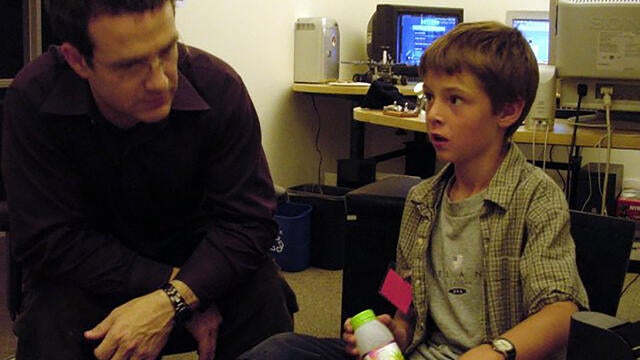
Ben enjoys a bottle of limeade during a weekly meeting in EJ’s office at LucasArts in 2004.
After eight months, the game was completed on a shoestring, or perhaps more accurately, a limeade budget. “Early on we figured out we both like limeade and I had a little fridge in my office, so I had to stock the fridge with limeade,” says EJ. “That was our only project expenditure really.”
“I mean, he’s a genius,” says Ben, of working with EJ. “He did this with no resources and an eight-year-old kid spitting ideas at him. Working with him was an absolute blast. He made every session feel absolutely incredible, and he was totally attentive.”
Upon launch, Ben’s Game was a hit. Ben’s story was told on every major network, including CNN, and even featured on The Today Show. The game ended up with over 300,000 downloads and was available in 11 different languages. A hospital in India used the game in its computer centers, as did several hospitals in Europe, and the game was featured in a newspaper in Japan.
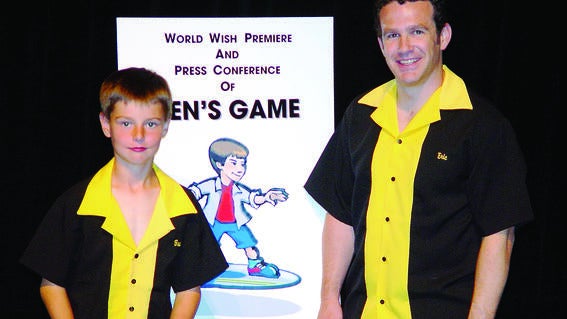
Ben and EJ at the launch of Ben’s Game in 2004.
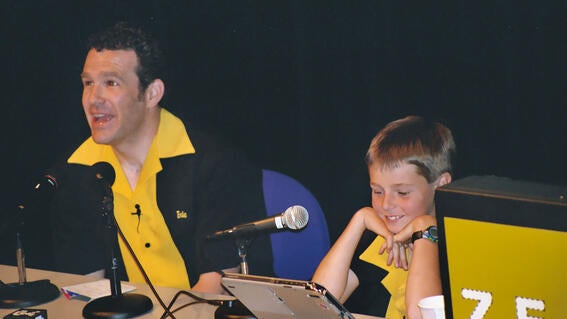
Ben and EJ speak at the launch of Ben’s Game in 2004.

Ben receives an award during his wish celebration and video game launch.
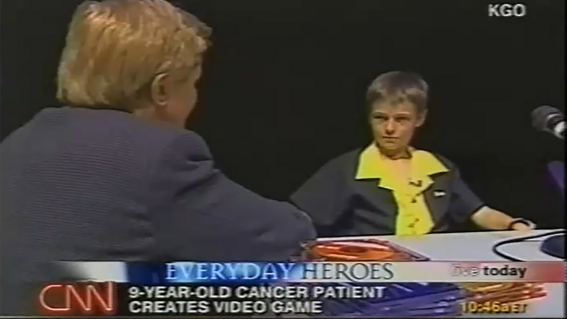
Ben was interviewed by CNN the day of his wish celebration in 2004.
“It ended up helping kids and families undergoing treatment all around the world,” says Ben. “In no way could I have ever imagined that it would’ve reached so far and touched so many people’s lives.”
In 2005, both Ben and EJ were recognized as “Unsung Heroes of Compassion” by the Dalai Lama. Ben was the youngest person to receive that honor.
“One of the beauties about my wish is that I’ve had the pleasure to meet so many people,” said Ben. “There are so many people doing amazing things in this world and it’s just such a great bridge to be able to connect with them.”
In 2024, Make-A-Wish Greater Bay Area celebrates its 40th Birthday and Ben’s Game is celebrating its 20th anniversary since launching in 2004. It’s fitting that Ben is also marking an incredible milestone—20 years cancer-free since his bone marrow transplant in 2004.
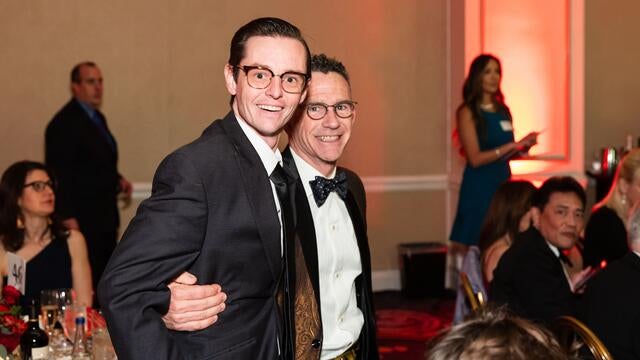
Ben and EJ at the 2024 Evening of Wishes: Birthday Bash, where the chapter shared Ben’s story with gala attendees.
"When I was younger, I really wanted to be a doctor,” says Ben. “But I didn’t want to go to med school after everything, so I ended up getting my master's in biotech.”
Today, as a senior lab technician at a biotech company, Ben assesses the efficacy of vaccines by testing clinical trial patients' blood and bone marrow.
“It’s a real full circle moment for me and I’m just very thankful,” he says. “I’m now a character in my own game.”
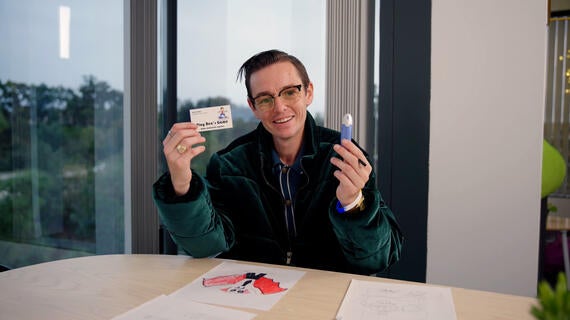
Watch Ben’s wish alum video
Read more stories about the wishes and people that shaped our 40-year legacy.